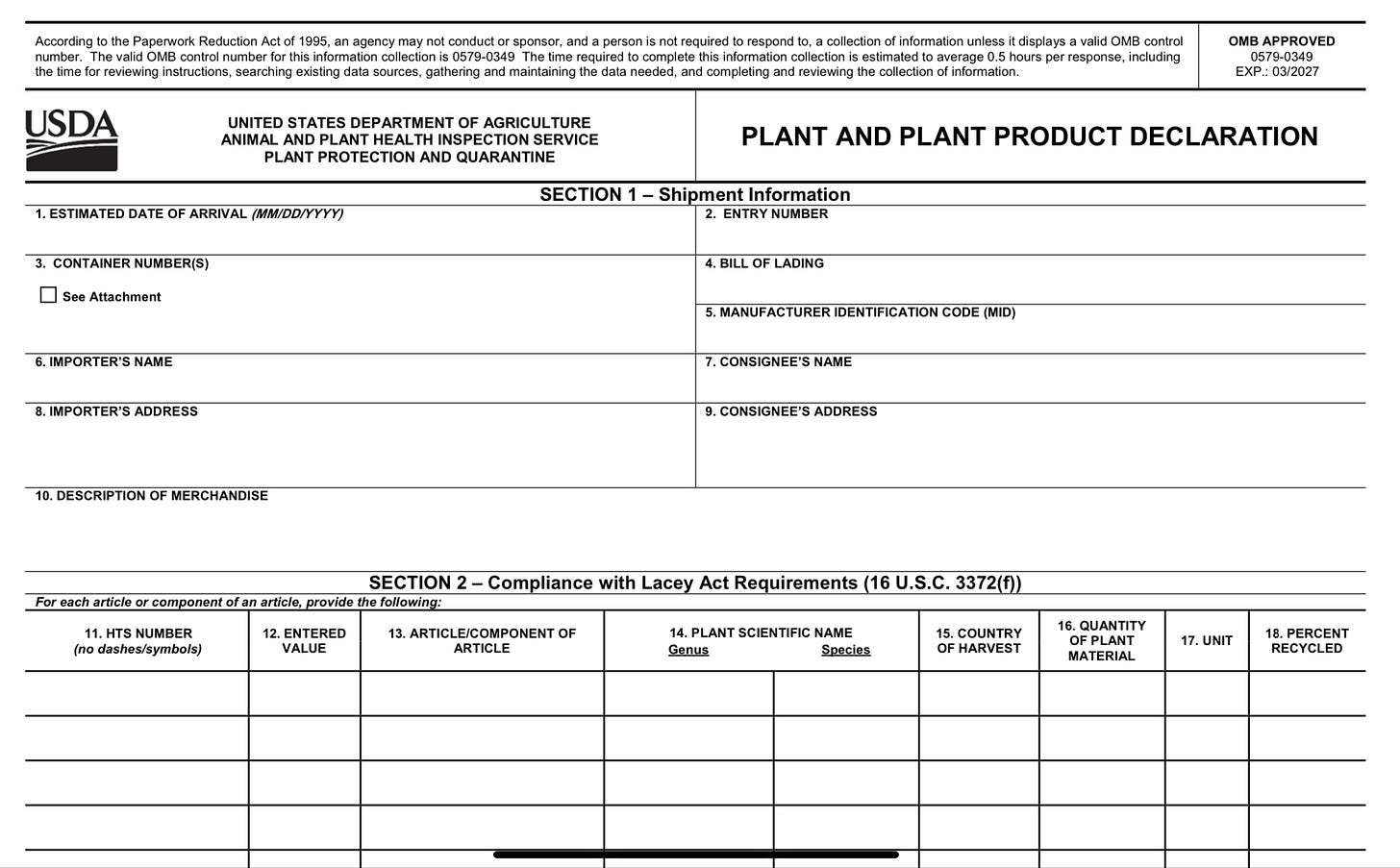The Lacey Act and Foreign-Built Vessels
What You Need to Know Before Importing a Foreign-Built Vessel
Importing a foreign-built boat into the United States used to be fairly straightforward. Fill out a form, pay the duty, get an Entry Summary, known as Form 7501, to prove it, and you were in business. But that changed with the 2008 amendment to the Lacey Act, an obscure law that now adds a critical layer of environmental compliance to the importation process, and it’s catching many boat sellers, buyers, and brokers off-guard.
If you’re considering importing a Lagoon, Fountaine Pajot, Leopard, Nautitech, Bali, Outremer, Knysna, Windelo, or any other foreign-built catamaran, it’s essential to understand how this law works, and how it could impact your ability to bring that boat into the U.S.
A Brief History of the Lacey Act
The Lacey Act was enacted in 1900 to combat illegal wildlife trafficking in the United States. It’s one of the oldest wildlife protection laws in the country1. But it wasn’t until 2008 that the Lacey Act was significantly amended to include plants and plant products, such as wood-based goods. Following the 2008 amendments, the U.S. Department of Agriculture’s Animal and Plant Health Inspection Service (APHIS) adopted a phased rollout strategy to enforce the new requirements, which began applying to the marine industry starting in December 2024.2
The updated law makes it illegal to import products made from illegally sourced wood into the U.S. The goal was to reduce illegal logging and associated supply chains around the world. It also aims at protecting forests and endangered wildlife that rely on them, but can also be used for political reasons as a means of placing embargoes on products from certain countries under the guise of environmental protection. The profound effect on industries outside of logging has been significant, and include musical instruments such as guitars, home furniture and furnishings, picture frames, and now boats.
From Guitars to Catamarans: The Unexpected Impact
The first industry to feel the weight of the amended Lacey Act was the musical instrument industry. Companies were raided by federal authorities and fined for importing wood into the U.S. that didn’t meet the documentation requirements, even if the wood was harvested years earlier. Gibson Guitars is the most well known to feel the pain of the Lacey Act, which included a raid on its Nashville location in both 2009 and 2011, resulting in over $600,000 in fines, confiscated products, and penalties payable to U.S. Fish & Wildlife for service and awareness programs.3
Today, a similar problem is hitting the boating industry, particularly in the world of sailing catamarans, where boats are often built overseas using a variety of wood products sourced globally.
This is where it gets complicated: As of December 2024 The US Department of Agriculture now requires importers to file a Lacey Act Declaration for vessels, identifying the species and country of harvest for every type of wood used in the build, and to also identify where that piece of wood is located on or in the boat, how much was used, and the value4. Much of the wood used on boats, especially older boats, are not easily accessible either, so if the manufacturer doesn’t have wood sourcing records, there’s often no way to fulfill this requirement retroactively, and the boat may never be capable of being imported unless the law is changed or enforcement ends. For Sellers of previously imported foreign-built boats that are older than 2013 model years, this adds value to your boat in theory, especially if you have a rare make/model. For Buyers, you may have to pay more if you want a boat that has been U.S. imported, especially if it’s a rare older boat.
What’s Required to Import a Foreign-Built Vessel Today?
Until recently, most boat owners only worried about the typical 1.5% import duty assessed on the value of a foreign-built recreational vessel. These rates changed in 2025 by Executive Order of the President of the United States, and now not only vary by country of origin, but with the implementation of the Lacey Act, payment of the duty, no matter the amount, is no longer enough.
To legally import a boat under the Lacey Act, you now need a signed Lacey Act Declaration (Form PPQ 505) and be able to provide detailed wood species and country of harvest documentation from the builder or manufacturer, along with verifiable information for all wood and plant-based materials used in construction. On a boat, think of flooring, veneer, cabinetry, wood core, equipment mounting blocks, marine plywood used in or around mast compression posts, bulkheads, and more!
In short, if your boat contains wood (and it almost certainly does), you need the builder to provide a traceability report showing the legal sourcing of those materials. Without it, you cannot complete a Lacey Act filing, and the boat cannot be legally imported into the U.S., regardless of whether duty has been paid.
Why Older Boats Are at Risk
The biggest risk lies with older boats. If your boat was built before 2013, the manufacturer may not have the wood traceability records needed to satisfy Lacey Act requirements. That’s because Europe’s equivalent regulation, the EU Timber Regulation (EUTR), didn’t go into effect until March 2013.
Boats built prior to this often lack the required documentation, making it virtually impossible to comply with current U.S. import laws. And because the Lacey Act has no grandfather clause, older boats are held to the same standard as new builds. If, however, the owner of a boat imported their boat into the U.S. prior to the December 2024 Phase VII Lacey Act rollout to the marine industry, the owner will NOT need to have a Lacey Act filing, or reporting information about woods used in the boat construction process.
What This Means for Sellers and Buyers
If you’re selling a foreign-built catamaran to a U.S. buyer, you’ll need to contact the manufacturer and confirm whether they can supply the necessary Lacey Act documentation. Without it, the buyer cannot import the vessel, even if they’re willing to pay duty.
If you’re a buyer, make sure your broker understands the Lacey Act compliance process and how it may or may not impact you as a buyer. Not all do, and failure to comply can result in delays, legal complications, and even forfeiture of the vessel.
The Big Picture
The Lacey Act is more than just red tape. It’s a well-intentioned environmental safeguard with very real implications for the boating world. And while the law doesn’t specifically target catamarans, the ripple effect on foreign-built vessels is becoming impossible to ignore.
As the U.S. becomes stricter on environmental compliance and documentation, buyers and sellers of sailing catamarans must do their homework, and that starts with knowing whether your boat can even be imported.
The Lacey Act is codified in Title 16 and Title 18 of the United States Code. Specifically, it is found under 16 U.S.C. §§ 3371-3378 and 18 U.S.C. § 42.
U.S. Department of Agriculture, Animal & Plant Health Inspection Service (APHIS). “Lacey Act Overview.” https://www.aphis.usda.gov/plant-imports/lacey-act
APHIS. “Implementation Phases for the Lacey Act Plant Declaration Requirement.” (Updated March 1, 2024). https://www.aphis.usda.gov/plant-imports/lacey-act-declaration-phases
Roy Carpenter, “The Gibson Raid,” The Environmental Narratives Project, June 2, 2018, https://envnarratives.com/2018/06/02/gibson-raid/.
APHIS. “Filing a Lacey Act Declaration (PPQ Form 505).” https://www.aphis.usda.gov/plant-imports/file-lacey-act-declaration






